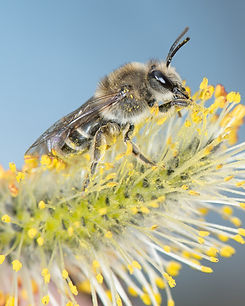
Family Megachilidae > Genus Paranthidium
Paranthidium
Resin Bees
In Minnesota, there is one described species within the genus Paranthidium—Paranthidium jugatorium. This species nests in pre-existing cavities belowground such as empty ground nests of other bees or burrows of other insects. To help form the nest structure, females collect plant resins to bind together soil particles, particularly in sandy soils.
Paranthidium jugatorium has a broad robust form, dark eyes, shaded wings, and a black integument with yellow markings on the head, thorax, and abdomen. This genus/species has an arolium (pad) between the tarsal claws, one characteristic to differentiate it from bees in the genus Anthidium. The forewing has two submarginal cells, and the second recurrent vein extends considerably beyond the second submarginal cell. The yellow bands on the abdomen are interrupted in the middle and occur in the middle of the tergites. Females collect pollen on hairs on the underside of their abdomen and are specialists (oligoleges) of late summer-blooming plants in the family Asteraceae such as Helianthus, Rudbeckia, and Heliopsis. Paranthidium jugatorium ranges in length from 6 to 11 mm (0.24 to 0.43 inches).

A Paranthidium jugatorium female visiting Heliopsis helianthoides.

wing
position
on flowers

N0. species in MN
1
size range

Phenology

Genus/Species Characteristics

Forewing with two submarginal cells. The 2nd recurrent vein extends considerably beyond the 2nd submarginal cell.
1
2

female
Interrupted yellow bands on the abdomen, occurring in the middle of the tergites (abdominal segments).

female
Black integument, dark eyes, and robust form. Females collect pollen on hairs on the underside of the abdomen.

male
Wings held outward at a 45° angle while visiting flowers. Male with yellow clypeus.


Resin nest lining
Distribution

Minnesota
Additional
records
Portman et al (2023)

Regional Map
Paranthidium jugatorium (Say, 1824) in GBIF Secretariat (2023). GBIF Backbone Taxonomy. Checklist dataset https://doi.org/10.15468/39omei accessed via GBIF.org on 2024-12-20.
Plant
Associations
Heliopsis helianthoides
(false sunflower)
Rudbeckia hirta
(black-eyed Susan)
Helianthus spp.
(sunflower)



Explore More Megachilidae Genera
Note: Two genera/species on the state list are not included in this guide: Ashmeadiella bucconis (last seen in Minnesota in 1949) and Trachusa zebrata (last seen in Minnesota in 1939). If either of these species is rediscovered in the state, they will be added to the guide at that time.
Explore Bee Families

Apidae
15 genera, 133 species
Bumble bees Bombus
Longhorn bees
Epimelissodes, Eucera, Melissodes
Carpenter bees
Ceratina, Xylocopa
Honey bees Apis
Digger bees Anthophora
Cuckoo bees Brachymelecta, Epeolus, Holcopasites, Nomada, Neolarra, Triepeolus
Squash bees Xenoglossa

2 genera, 39 species
Halictidae
10 genera, 133 species
Metallic green sweat bees
Agapostemon, Augochlora, Augochlorella, Augochloropsis
Large sweat bees
Dieunomia, Nomia
Short-faced bees Dufourea
Sweat bees Halictus
Small sweat bees Lasioglossum
Cuckoo (blood) bees Sphecodes
Megachilidae
14 genera, 86 species
Resin and pebble bees Anthidiellum, Dianthidium, Heriades, Paranthidium
Carder bees Anthidium, Pseudoanthidium
Mock orange bees Chelostoma
Mason bees Osmia, Hoplitis
Leafcutter bees Megachile
Sharp-tailed cuckoo bees Coelioxys
Dark cuckoo bees Stelis

Citations and Further Reading
Droege, S., et al. (2024). The Very Handy Bee Manual: 2.0. How to Catch and Identify Bees and Manage a Collection.
Gibbs, J., Hanuschuk, E., Miller, R., Dubois, M., Martini, M., Robinson, S., ... & Onuferko, T. M. (2023). A checklist of the bees (Hymenoptera: Apoidea) of Manitoba, Canada. The Canadian Entomologist, 155, e3.
Mitchell, T. B. (1960). Bees of the eastern United States. Technical Bulletin No. 141. North Carolina Agricultural Experiment Station.
Portman, Z. M., Gardner, J., Lane, I. G., Gerjets, N., Petersen, J. D., Ascher, J. S., ... & Cariveau, D. P. (2023). A checklist of the bees (Hymenoptera: Apoidea) of Minnesota. Zootaxa, 5304(1), 1-95.
Wilson, J. S., & Messinger Carril, O. J. (2016). The bees in your backyard: a guide to North America's bees. Princeton University Press.
Page Photography Credits
Heather Holm


















